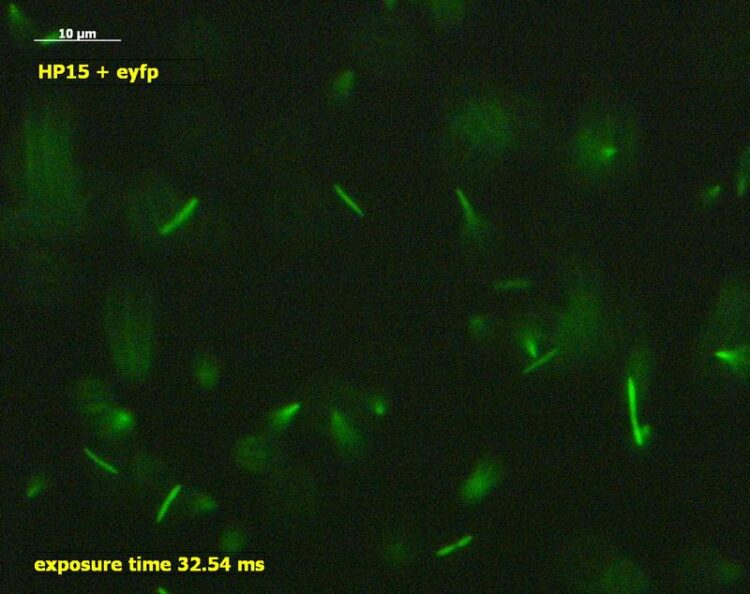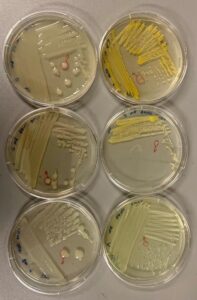Research breakthrough: How CO2 affects our oceans

Marine bacteria tagged with fluorescence are investigated in the laboratory for chemotaxis using a microscope.
(c) Constructor University
The behavior of microorganisms is crucial to understand the effects of carbon dioxide input in the oceans. Researchers at Constructor University in Bremen, Germany, in collaboration with colleagues from Australia, the United States and Switzerland, have now gained new insights into the metabolic exchanges between microorganisms. The research results were recently published in the renowned journal Nature Microbiology.

(c) Constructor University
Microorganisms are central components of marine ecosystems; among other things, they produce oxygen and bind carbon dioxide. “Until now, it was assumed that the diffusion of nutrients depends on the size of the cell,” said Professor Dr. Matthias Ullrich, a microbiologist at Constructor University and one of the study’s co-authors. The larger a cell, the more substances it releases, producing a greater attraction on smaller, motile organisms at the same time. The technical term chemotaxis describes this orientation movement triggered by chemical stimuli.
The researchers have now shown that smaller cells of the same size can also be recognized by chemotaxis. This means that there are metabolic relationships between some of the most common microorganisms in the oceans, which are by no means only one-sided, as previously assumed. Photosynthetic organisms not only supply consuming bacteria with carbohydrates, but also receive nutrients from them, meaning they behave actively.
“To better understand carbon exchange in the oceans, it is crucial to know more about the exchange mechanisms of microorganisms,” Ullrich said and added, “In the future, researchers in microbiology will monitor even more closely how microorganisms of the same size exchange substances.”
This discovery was only made possible by fundamental research at Constructor University in Bremen. About a decade ago, researchers led by Professor Ullrich had already decoded the genes of a single bacterium. They determined which genes contribute to the recognition and binding of a cell. Eva Sonnenschein, then a PhD student who now teaches as a professor at the University of Swansea in Wales, was involved in the research at that time and contributed to the current study. The research was largely driven by scientists from several Australian universities, the Massachusetts Institute of Technology in the USA and the Swiss Federal Institute of Technology in Zurich.
Wissenschaftliche Ansprechpartner:
Prof. Dr. Matthias Ullrich | Professor of Microbiology
mullrich@constructor.university | +49 421 200-3245
Originalpublikation:
https://www.nature.com/articles/s41564-023-01327-9
Weitere Informationen:
Media Contact
All latest news from the category: Life Sciences and Chemistry
Articles and reports from the Life Sciences and chemistry area deal with applied and basic research into modern biology, chemistry and human medicine.
Valuable information can be found on a range of life sciences fields including bacteriology, biochemistry, bionics, bioinformatics, biophysics, biotechnology, genetics, geobotany, human biology, marine biology, microbiology, molecular biology, cellular biology, zoology, bioinorganic chemistry, microchemistry and environmental chemistry.
Newest articles

A universal framework for spatial biology
SpatialData is a freely accessible tool to unify and integrate data from different omics technologies accounting for spatial information, which can provide holistic insights into health and disease. Biological processes…

How complex biological processes arise
A $20 million grant from the U.S. National Science Foundation (NSF) will support the establishment and operation of the National Synthesis Center for Emergence in the Molecular and Cellular Sciences (NCEMS) at…

Airborne single-photon lidar system achieves high-resolution 3D imaging
Compact, low-power system opens doors for photon-efficient drone and satellite-based environmental monitoring and mapping. Researchers have developed a compact and lightweight single-photon airborne lidar system that can acquire high-resolution 3D…





















